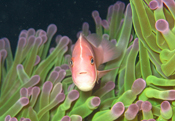Interactions
A major mutualistic symbiotic relationship
exists between this anemone fish and the anemones that these
fish call home. The sea anemones that
Amphirprion perideraion
live within are of the Cnidarian family. The anemones have
nematocysts on their tentacles that aid i n
the protection and capturing of prey that the both species in
the mutualistic relationship. In return the clownfish actually
protect the sea anemone by fighting off any predators that want
to attack the anemone when they are vulnerable. Anemones are
vulnerable when their tentacles have lost some of the
nematocysts (Drury 2008). Not only is this relationship for
protection, it has been recently discovered that the anemone
fish actually benefit the anemone with gas and nutrient exchange
as well (Szczebak et al.
2013).
n
the protection and capturing of prey that the both species in
the mutualistic relationship. In return the clownfish actually
protect the sea anemone by fighting off any predators that want
to attack the anemone when they are vulnerable. Anemones are
vulnerable when their tentacles have lost some of the
nematocysts (Drury 2008). Not only is this relationship for
protection, it has been recently discovered that the anemone
fish actually benefit the anemone with gas and nutrient exchange
as well (Szczebak et al.
2013).
Since anemones have nematocysts, how in the
world do these clownfish avoid the sting of the anemone that all
other organisms encounter? The answer is actually that the clownfish
coats itself with mucus, which allows the sea anemone to recognize
its houseguest. In a way the mucus acts as a communication device so
that the anemone doesn’t sting the fish (Winiarski 1997). How or
where the mucus comes from is a complete mystery to many scientists
and only hypotheses have been developed. All that is known for sure is
that the mucus allows for this amazing symbiotic relationship (Winiarski 2008).
relationship (Winiarski 2008).
There is such a large amount of diversity
present on a coral reef that it is hard to distinguish exactly which
organisms the one specific species of clownfish interact with. A lot
of the well-known reef animals include multiple species of
 corals,
sponges, many different fish species and of course the zooplankton
of which the clownfish mainly feed on (Sheppard et al. 2009). This
large diversity in one area of a coral reef makes it very difficult
to distinguish between different species within the same genus
however, the best known way is by looking at the individual fishes
and organisms color patterns. Many species related to
Amphirpion perideraion
have very similar color patterns making it very difficult in the
diversity of coral reef to see this individual species (Timm et al.
2008).
corals,
sponges, many different fish species and of course the zooplankton
of which the clownfish mainly feed on (Sheppard et al. 2009). This
large diversity in one area of a coral reef makes it very difficult
to distinguish between different species within the same genus
however, the best known way is by looking at the individual fishes
and organisms color patterns. Many species related to
Amphirpion perideraion
have very similar color patterns making it very difficult in the
diversity of coral reef to see this individual species (Timm et al.
2008).
Back to Home Continue to References
